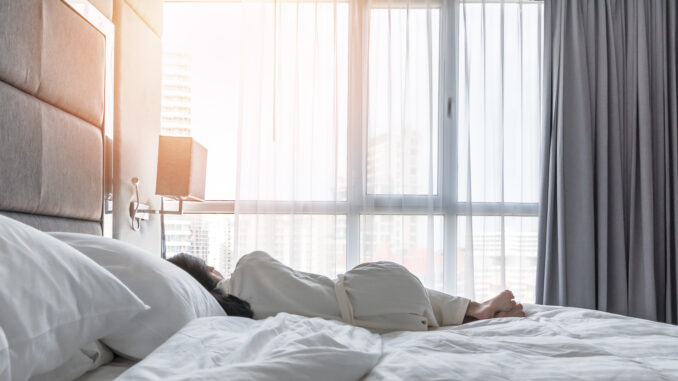
By Larry and Adam Mogelonsky - 6.15.2025
Sleep tourism is a very real trend. Working closely with hotel owners and executives to help ideate and set up sleep programs at hotels, one of the most common challenges that we have to overcome is limiting capex and opex so that the sleep program is both turnkey and easy to operationalize as well as acceptable to the guest’s price elasticity. Luckily, there’s a principle in sleep science that hotels can leverage to aid in guest’s sleep purely by better utilizing existing merchandizing and inventory systems.
When it comes to sleep, there’s something called the first night effect (FNE). In essence, every time we spend the first night trying to sleep in a new environment, some corner in the deep recesses of our minds can’t help but stay active to maintain a vigilant eye in catch of lions, tigers or bears. This ends up resulting in longer time to fall asleep (sleep onset) or, potentially, bouts of sleep maintenance insomnia where you wake up in the middle of the night and can’t dose back off.
Nor is this a universal principle: some people never experience FNE, others who usually suffer may be so exhausted from a long travel day that once they get in the room they simply collapse for a solid 6-8 hours.
Overall, what FNE implies for hotels is that regardless of whether your room is a plush, luxurious sleep cave or a more rustic pied-à-tierre, some people will simply not experience high sleep quality. The risk therein is due to a ‘halo effect’ whereby guests who are not cognizant of their own unconscious FNE issues will psychologically transfer that crummy night’s sleep onto their perception of the hotel.
Before you throw your hands up in the air in a grand motion of giving up, there are indeed a lot of highly creative and low-cost ways to attenuate the pitfalls of FNE for your guests. Many of these would take a whole novella to describe, so let’s focus on just one solution that you can likely do using one aspect of FNE then applying it to some combination of your booking engine, your PMS and your CRM.
It’s been found for FNE that your unconscious mind can be partially hacked to interpret new surroundings as familiar to help prevent an interpretation of said place as dangerous. Familiar scents are frequently cited in studies as helping with FNE, but for the road warrior who frequently visits the same city again (and as an average LOS of around 1.2), what’s recommended is to stay at the same hotel and in the exact same room as the previous stay.
To address the first one – same hotel – this is perhaps the holy grail of every urban hotel: win a customer for life who has a high LTV and get them to book direct every single time.
The big chains that have saturated a given market with different flags may help differently – that is, by trying to get their loyalty members to try somewhere new within their family of brands – so if you are reading this and part of a chain, I’ll leave that to you to solve for the repeat guest challenge. An idea: perhaps a digital pamphlet as part of the post-departure marketing journey discussing the benefits of staying in the same hotel for sleep?)
It’s the second aspect that gets me excited for the here and now: staying in the same room as you’ve previously stayed.
This would be for situations where you have a guest returning to a given property and the hotel’s system has identified that they are a returning guest. Irritatingly, this is already a problem as you may have guests coming for the first time through an OTA then coming back through your OBE; match and merge or deduplication features within a CDP or CRM work wonders here.
So, wouldn’t it be great to ask guests at some point during the booking or prearrival experience if they would like to stay in the same room as before? It could be a checkbox within the OBE, part of a customized intake form or embedded as an attribute-based shopping (ABS) request within a prearrival upselling newsletter.
Staying in the same room as before could even be explained as beneficial to one’s sleep based on the theory of FNE in order to induce more sales of this particular upsell. The next question then is how much would you charge for this service?
Right now, such recurrent room assignments are often handled manually and subject to availability, group room blocks, VIPs and other yielding tools. Nevertheless, with some policy changes and a reasonable price tag for securing the same room as before, this has the makings of extra revenue that also serves a good cause (helping guests get a good night’s rest). You may not have the solution for how to implement this right now, so just sleep on it and see what eureka moment you might have.
 Together, Adam and Larry Mogelonsky are the principals at Hotel Mogel Consulting Ltd., an asset management and hotel development consultancy. Their experience encompasses properties around the world, both branded and independent in the luxury and boutique categories. Their writing includes eight books: “Total Hotel Mogel” (2024), “In Vino Veritas: A Guide for Hoteliers and Restaurateurs to Sell More Wine” (2022), “More Hotel Mogel” (2020), “The Hotel Mogel” (2018), “The Llama is Inn” (2017), “Hotel Llama” (2015), “Llamas Rule” (2013) and “Are You an Ostrich or a Llama?” (2012). You can reach them at adam@hotelmogel.com to discuss business challenges or for speaking engagements.
Together, Adam and Larry Mogelonsky are the principals at Hotel Mogel Consulting Ltd., an asset management and hotel development consultancy. Their experience encompasses properties around the world, both branded and independent in the luxury and boutique categories. Their writing includes eight books: “Total Hotel Mogel” (2024), “In Vino Veritas: A Guide for Hoteliers and Restaurateurs to Sell More Wine” (2022), “More Hotel Mogel” (2020), “The Hotel Mogel” (2018), “The Llama is Inn” (2017), “Hotel Llama” (2015), “Llamas Rule” (2013) and “Are You an Ostrich or a Llama?” (2012). You can reach them at adam@hotelmogel.com to discuss business challenges or for speaking engagements.
Are you an industry thought leader with a point of view on hotel technology that you would like to share with our readers? If so, we invite you to review our editorial guidelines and submit your article for publishing consideration.
